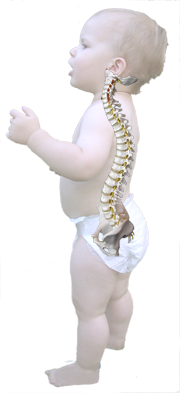“As the twig is bent, so grows the tree.”

The curves of our spine are developed in the first year of our life. As are the length-tension relationships between muscles between our flexors and extensors.
To assist healthy development of your child’s spine Shirley Rd Chiropractic makes the following basic recommendations:
Encourage your child to crawl

This helps to develop their brain and coordination and also develops the muscles in their low back that contribute to their good spinal curves. One of the key factors in helping your child to crawl is plenty of “tummy time”. This will help them develop the coordination, movement patterns and muscles they need to become a good crawler. It is also important to not sit your child for long periods before they have learnt to sit themselves. This will generally occur around the same time that they begin to crawl. Sitting them too early can lead to “bum shuffling” and failure to crawl.
Don’t encourage your child to walk too early

Encouraging your baby to walk pre-maturely may inhibit the amount of crawling your child does and place unnecessary stress on their developing spine. Let them walk in their own time – it is not a race to have them walking before their first birthday. In fact, if they learn to walk holding a walking trolley or being encouraged by holding someones hands out in front, they are more likely to develop tightened hip flexors and tight hamstring muscles in their legs. This may lead to poor flexibility as an adult. “Baby-walkers” are also not a good idea for the health of their spine and they are also potentially unsafe as they may pose a falls risk.
Avoid using vertical baby pouches while your child is still unable to stand
Their spines are unable to take vertical loads as the muscles, coordination and strength are yet to develop. It is thought that these pouches may increase the risk of a stress fracture that can develop in the lower spine. If a similar idea is necessary the African-style horizontal sling is a better idea as it will place less vertical load on their spines.
Key development ages that children should be evaluated for spinal joint dysfunction and development progress
- 6 weeks
- 3 months
- 4-5 months
- 6 months
- 9 months
- 12 months
- 15 months
- 18 months
- 24 months
- Every 6 months thereafter until school entry.1

Marianne Hermsen-van Wanrooy has written an excellent guide to the healthy physical development of your newborn to 18 month old. With easy to read text, many pictures and a “What to do” and “What not to do” section in each chapter, it is a must for new parents. Baby Moves is available through http://www.babymoves.co.nz.
Being our best as an adult is largely shaped during childhood. While many parents bring their children in when they are suffering from plagiocephaly (“flat-head” syndrome) / brachycephaly / scaphocephaly, colic or bed-wetting it is important to realise that we are not treating their symptoms. As chiropractors we check on spinal and cranial function and correct underlying mechanical issues.
At Shirley Rd Chiropractic we have undertaken further study and courses in Chiropractic Paediatrics so that we are able to further help children be their best. We are happy to work closely with your GP or paediatrician to offer you the best possible co-management strategy possible. The techniques that we use on children are of very gentle pressure and do not involve high-velocity manipulation techniques with “pops and cracks”.
Learn more about plagiocephaly.
References
- Davies, N. (2000) Chiropractic Pediatrics. Churchill Livingstone. Harcourt Publishers Limited. p4.
